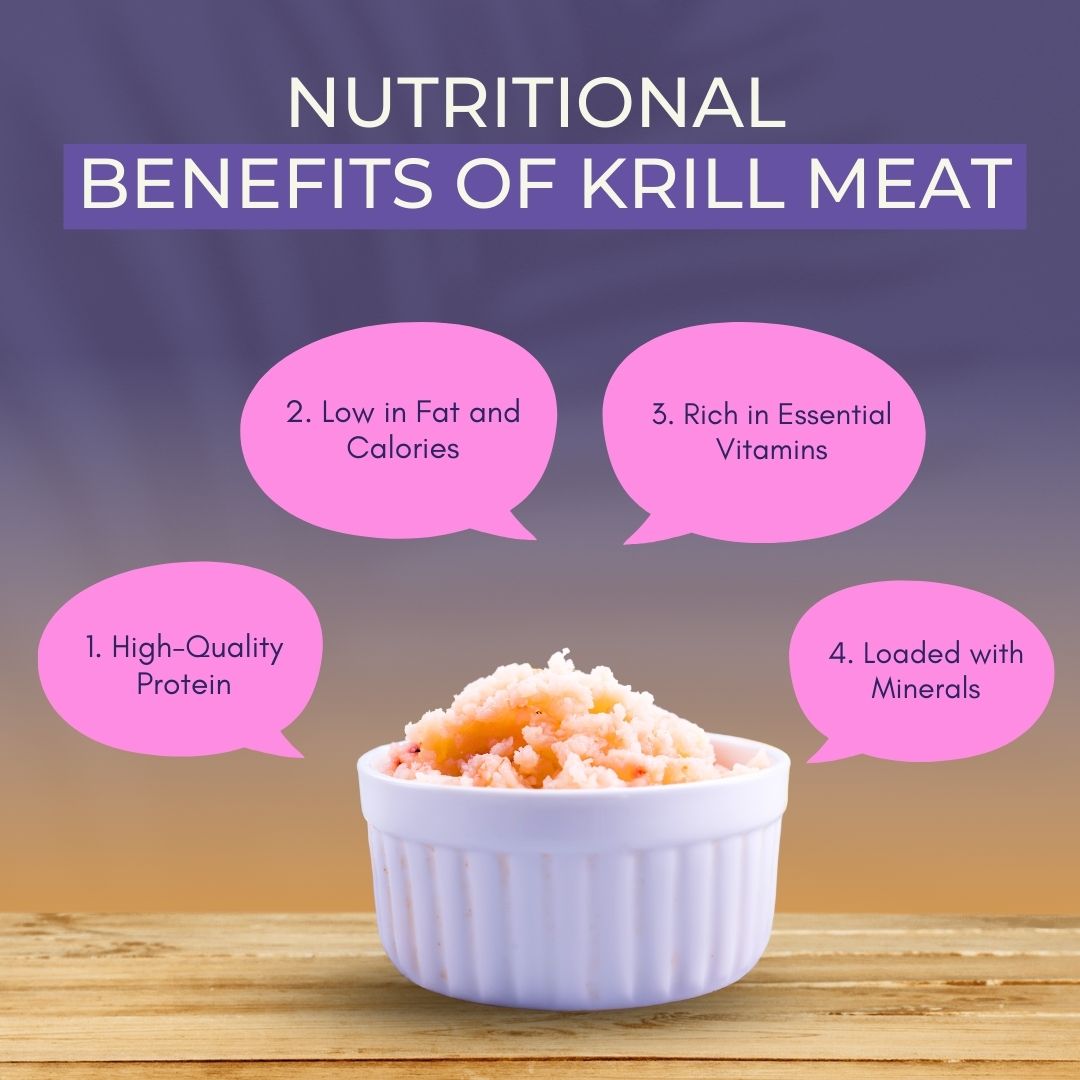Waking up with stiff, aching joints isn’t just frustrating it can shape your whole day. Maybe it’s harder to grip your coffee mug, stretch your fingers, or even get out of bed without wincing. Millions of people deal with arthritis every single day, and the pain and stiffness can make even the simplest things feel like too much.
If you’re looking for a new way to find relief, consider the connection between krill meat and arthritis it’s an option you might not have thought about before. Relief could come from one of the smallest creatures in the ocean.
Krill are tiny, shrimp-like crustaceans that live in cold waters. You’ve probably heard about krill oil, but not many people talk about the meat itself and they should. Krill meat is packed with the kind of nutrients your joints love: omega-3s that help calm inflammation, antioxidants that protect your cartilage, and clean protein to supports the muscles around your joints.
It’s about real food doing real work and supporting your body in meaningful ways. Keep reading to learn exactly how it fights joint pain, how much you should eat, and how to incorporate it into your meals without making life more complicated.
What Is Arthritis and Why Does It Hurt?

Arthritis isn’t just one condition it’s a name for over 100 types of joint problems. The most common symptoms are pain, stiffness, and swelling, all caused by joint inflammation.
In osteoarthritis, the cartilage that cushions your joints wears down over time, usually from aging or repeated use. In rheumatoid arthritis, the immune system mistakenly attacks healthy joints, causing painful inflammation and flare-ups.
No matter the type, arthritis makes everyday movements harder because the joints aren’t working as smoothly as they should. The more inflammation, the more damage, and the more pain.
That’s why calming inflammation is so essential. Krill meat offers natural nutrients that help reduce swelling and protect joints from further wear and tear.
Why Krill Meat? A Small Seafood with Big Benefits
Krill are these tiny, shrimp-like creatures swimming in chilly ocean waters, and their meat is like a treasure chest of nutrients for your joints.

Here’s why krill meat deserves a spot on your plate:
- Rich in Omega-3 Fatty Acids (EPA and DHA)
These healthy fats help reduce inflammation, the root cause of arthritis pain. Krill’s omega-3s are more easily absorbed than those from many fish, making them especially effective. - Contains Astaxanthin
This powerful antioxidant gives krill its red color and helps protect your joints from oxidative stress, which can wear down cartilage over time. - Packed with Choline
Choline supports your nervous system and helps regulate the body’s inflammation response, especially helpful in autoimmune forms of arthritis. - High in Lean Protein
A small serving provides about 15 grams, which keeps the muscles around your joints strong so they don’t have to work so hard. - Naturally Absorbable Nutrients
Krill meat is a whole food; your body can digest and use its nutrients more efficiently than it can with some supplements. - Light and Clean: A 3.5-oz serving has just 65–70 calories, no gluten, and way less junk like mercury than bigger fish like tuna.
If you’re looking for a natural, nutrient-dense way to support your joints, krill meat offers real benefits without relying on processed products.
How Krill Meat Helps with Arthritis Relief
If you’re struggling with arthritis pain, you’ve probably heard about omega-3 supplements. Krill is one of the most effective options, especially for people dealing with joint inflammation. Let’s break down how krill works to relieve arthritis symptoms and as a natural anti-inflammatory remedy.

Anti-Inflammatory Support from Omega-3s
Krill is rich in two essential omega-3 fatty acids: EPA (eicosapentaenoic acid) and DHA (docosahexaenoic acid). These nutrients help your body fight inflammation, a key cause of joint pain and stiffness in arthritis.
In people with conditions like rheumatoid arthritis and osteoarthritis, krill can help lower levels of C-reactive protein (CRP) and other inflammatory markers. The result? Less swelling, better mobility, and fewer painful flare-ups.
Better Absorption Than Fish
Rich in two essential omega-3 fatty acids: EPA and DHAOne big advantage krill has over regular fish is how it’s absorbed. Fish delivers omega-3s in the form of triglycerides; krill binds its omega-3s to phospholipids, which your body absorbs more efficiently.
This means
- You can take lower doses and still get the same (or better) benefits.
- Your body gets faster access to anti-inflammatory support.
This superior bioavailability makes krill a wise choice for managing arthritis naturally.
Antioxidant Power from Astaxanthin
Astaxanthin helps fight oxidative stress, which can damage joints over time and worsen arthritis symptoms. By reducing free radicals, krill helps protect your cartilage and connective tissue, supporting long-term joint health.
Supports Joint Lubrication and Cartilage Health
Krill doesn’t just fight inflammation it also helps lubricate joints and support cartilage repair. Omega-3s can slow collagen breakdown and the enzymes that wear down joint tissue.
That means
- Less grinding and stiffness.
- Smoother movement.
- Reduced long-term damage in conditions like osteoarthritis.
Helps Regulate the Immune Response
For people with autoimmune types of arthritis, like rheumatoid or psoriatic arthritis, krill offers an added bonus. It helps calm overactive immune responses, reducing the attack on healthy joint tissue.
Omega-3s in Krill do this by
- Modulating T-cell activity.
- Reducing inflammatory cytokines.
- Improving overall immune balance.
This makes krill a helpful complement to traditional arthritis medications or even a natural option for those seeking holistic relief.
How Much Krill Meat Should You Eat for Arthritis Relief?
Eating krill meat regularly can support your joints but like anything else, the results depend on how much you’re actually getting. While there are no official guidelines for krill meat intake, we can estimate based on its omega-3 content and research on inflammation.

Here’s what works for most people:
- Start with 3 to 4 ounces (about 85–115 grams)
Eat this amount of cooked krill meat 3 to 4 times per week. Each serving can provide around 250–500 mg of EPA and DHA, which is close to the amount shown to help reduce joint inflammation. - For ongoing or severe symptoms
If your arthritis is more active or chronic, consider eating smaller portions (2–3 ounces) daily to maintain steady support. This will keep anti-inflammatory nutrients more consistent in your system. - Give It Time: You might not feel a difference right away it could take 4–6 weeks of eating it regularly to notice less pain or easier movement.
How to Add Krill Meat to Your Diet
Adding krill meat to your meals doesn’t mean learning new recipes or overhauling your kitchen. It’s surprisingly versatile and fits into everyday dishes you already know how to make. The flavor is mild, somewhere between shrimp and crab, so it pairs well with many ingredients.

Here are easy ways to start:
- Toss it in a salad
Add a handful of cooked krill meat to a fresh green salad. A drizzle of olive oil and a squeeze of lemon make it a simple anti-inflammatory meal. - Mix into pasta or grain bowls
Stir krill meat into warm pasta, quinoa, or rice dishes. It blends right in and adds both flavor and protein without much effort. - Use it in wraps or sandwiches
Swap out tuna or chicken for krill meat. Add avocado or leafy greens for extra joint-friendly nutrients. - Add it to soups or stews
Add cooked krill meat during the last few minutes of simmering. This works well in vegetable or miso-style broths. - Pair it with other anti-inflammatory foods
Combine it with turmeric, ginger, garlic, or leafy greens to boost the joint-soothing effects even more.
You don’t need to eat krill meat daily, but including it a few times a week in meals you enjoy is a simple way to support your joints through real food.
Here’s a simple weekly chart to help you stay on track with no stress and no repeats.
| Day | Meal | Krill Boost |
| Monday | Lunch | 🥗 Toss krill into a green salad with olive oil & lemon |
| Tuesday | Dinner | 🍜 Stir into miso or veggie soup at the end of cooking |
| Wednesday | Lunch | 🌯 Use in a wrap with avocado and leafy greens |
| Thursday | Dinner | 🍚 Add to quinoa bowl with roasted veggies & turmeric |
| Friday | Lunch | 🥪 Swap tuna for krill in a sandwich with arugula & tomato |
| Saturday | Dinner | 🍝 Mix into warm whole wheat pasta with garlic & kale |
| Sunday | Light Dinner | 🥣 Add to a light stew with sweet potato & cumin |
Heads-Up: Who Should Take It Slow?
Krill meat is safe and beneficial for most people, but it’s not for everyone. Like any food, knowing how your body might react is essential, especially if you have certain health conditions or take medication.
Here’s when to pause and check with a doctor first:
- If you have a shellfish allergy
Krill is a crustacean, just like shrimp or crab. If you’re allergic to shellfish, avoid krill meat completely it could cause a severe reaction. - If you take blood thinners
The omega-3s in krill meat may slightly thin your blood. If you’re on medications like warfarin or aspirin, talk to your doctor before adding large amounts to your diet. - If you’re pregnant or breastfeeding
There’s not much research on krill meat during pregnancy or nursing. To stay safe, check with your healthcare provider before including it regularly. - stir krill meat into warm pasta, quinoa, or rice dishes. If you’re unsure about how your body will react
Start small. Try a small serving and see how you feel. Most people tolerate krill meat well, but it’s smart to ease into it.
A little caution goes a long way especially when you’re adding something new to your diet. The good news? If krill meat works for you, it can be a safe, natural tool in your arthritis relief plan.
Wrap-Up: Small Bites, Big Relief
Arthritis doesn’t just slow you down it can wear you out. But small, consistent changes in your arthritis relief diet can help ease the pressure on your joints and give your body the support it’s been missing.
Krill meat stands out as a natural, whole-food option that delivers more than just calories. With its rich blend of omega-3s, antioxidants, choline, and lean protein, it gives your joints the exact kind of fuel they need to move with less pain and more freedom.
Start simple. Try one meal. Give your body time. The results won’t come overnight, but with steady effort, you may feel the difference where it matters most in your joints.








